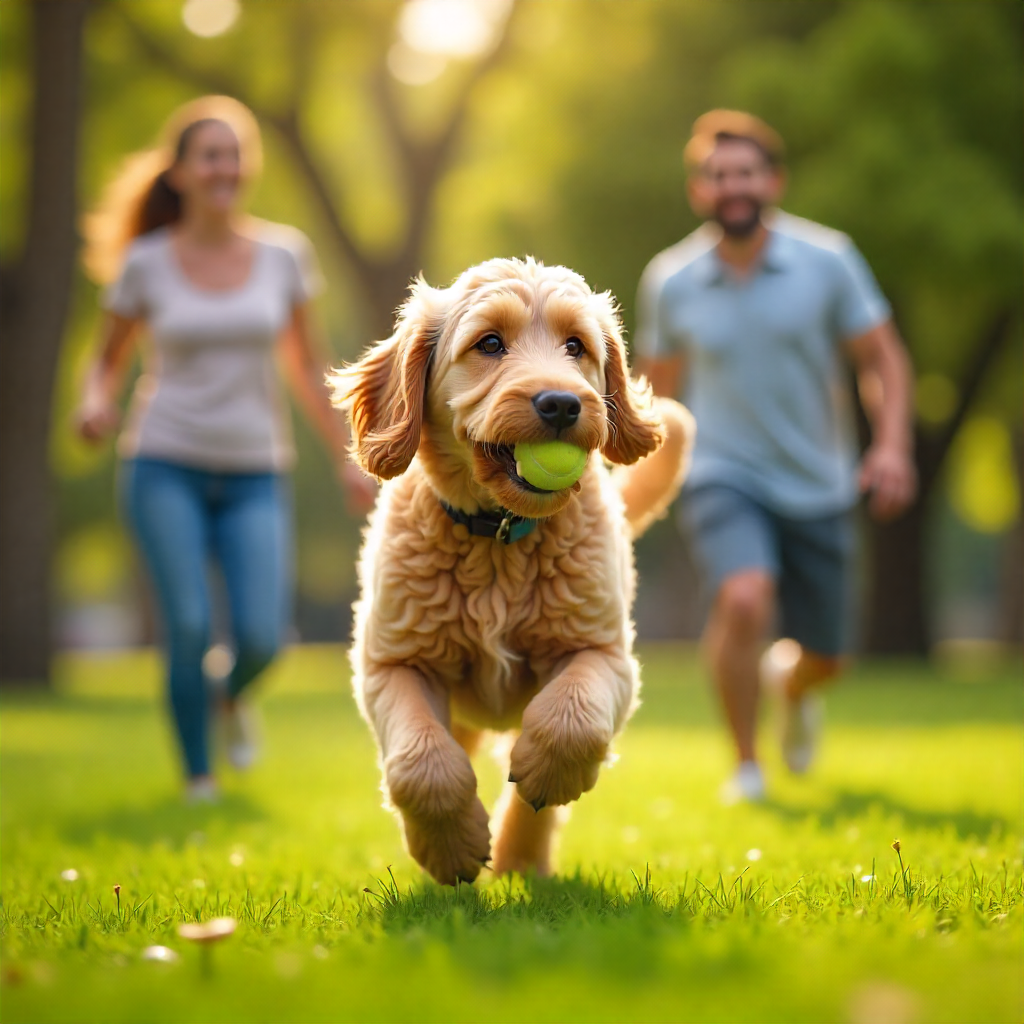With their fluffy coats, warm eyes, and whimsical name, Goldendoodles have captured the hearts of families worldwide. A cross between the intelligent Golden Retriever and the clever, hypoallergenic Poodle, these “designer dogs” are often sought after for their promised blend of the best traits from both parent breeds. But what is it really like to raise a Goldendoodle puppy? Is their temperament as perfect as the Instagram photos suggest?
This comprehensive Goldendoodle puppy guide will go beyond the hype to give you a realistic, detailed look at their personality, training needs, and the unique considerations that come with welcoming one of these charismatic hybrids into your home. Whether you’re a first-time owner or a seasoned dog lover, this guide will equip you with the knowledge to nurture your Doodle from a wiggly puppy into a magnificent, well-mannered adult dog.
Decoding the Doodle: First, Understand the Genetics 🧬
Before diving into temperament, it’s crucial to understand that not all Goldendoodles are the same. Their traits can vary significantly based on their generation. This is a key part of any true goldendoodle puppy guide.
- F1 Goldendoodle: A first-generation cross between a purebred Golden Retriever and a purebred Poodle (50/50). These pups often have a wavy, low-shedding coat but can have a wider range of traits from both parents.
- F1B Goldendoodle: The most common choice for allergy sufferers. This is a cross between an F1 Goldendoodle and a Poodle (75% Poodle, 25% Golden Retriever). They are more likely to have a curlier, non-shedding coat and can exhibit stronger Poodle traits.
- F2 (or Multigen) Goldendoodle: A cross between two F1 Goldendoodles. This generation has the most genetic variability, meaning predictability of coat type and temperament is lower.
Why this matters: An F1 puppy may have a stronger retrieving drive and slightly more shedding, while an F1B might be more reserved and have a higher energy intellect. Always meet the parent dogs if possible, as they are the best predictors of your puppy’s adult personality.
The Goldendoodle Puppy Temperament: What to Really Expect ❤️
While individuals vary, well-bred Goldendoodles generally inherit a wonderful combination of traits that make them fantastic family companions.
The Glowing Strengths 👍
- Friendly & Social: This is their hallmark. Bred from two extremely people-oriented breeds, Doodles are typically outgoing, affectionate, and thrive on human companionship. They are usually great with children and other pets.
- Intelligent & Trainable: With both parent breeds ranking among the smartest, Goldendoodles are quick learners who excel in obedience, agility, and therapy work. They are eager to please and highly responsive to positive reinforcement.
- Playful & Energetic: They retain a joyful, puppy-like demeanor well into adulthood. They love to play fetch, go for hikes, and participate in family activities.
- Adaptable: Their generally easy-going nature allows them to thrive in various living situations, from apartments to farms, as long as their exercise and mental needs are met.
The Potential Challenges to Manage 👎
- Prone to Separation Anxiety: Their deep devotion to their families means they hate being alone. Without proper training, this can lead to destructive chewing, barking, and other anxiety-driven behaviors.
- High Energy & Exercise Needs: A bored Doodle is a destructive Doodle. They are not couch potatoes and require significant daily physical and mental exercise to prevent them from creating their own (often undesirable) fun.
- “Doodle Drama”: Some individuals can be vocal and excitable, expressing themselves with whines, groans, and barks when they are happy, sad, or want something.
- Jumping & Mouthing: Their exuberant, friendly nature often manifests as jumping on people and mouthing (nipping at) hands and clothes during play. Consistent training from day one is essential to manage this.
The Golden Rules of Goldendoodle Puppy Training 🎓
Their intelligence is a double-edged sword: they learn what you want them to and what you don’t with equal speed. Effective training is non-negotiable.
1. Start Early & Socialize, Socialize, Socialize! 🌍
Socialization is the most critical task for any Doodle owner. Between 8 and 16 weeks, expose your puppy to a wide variety of:
- People (men, women, children, people with hats, umbrellas, etc.)
- Other vaccinated, friendly dogs
- Sounds (traffic, vacuums, doorbells)
- Surfaces (grass, gravel, tile, wood)
- Environments (parks, pet-friendly stores, urban streets)
Do this positively and safely to build a confident, well-adjusted adult dog who is not fearful or reactive.
2. Master the Art of Positive Reinforcement 🍪
Goldendoodles are sensitive souls who shut down with harsh correction. They thrive on:
- High-Value Treats: Use small, soft, smelly treats to motivate them.
- Praise & Play: enthusiastic praise and a quick game of tug can be even more rewarding than food.
- Keep it Short & Fun: Training sessions should be 5-10 minutes long to keep your pup engaged.
3. Priority #1: Prevent Separation Anxiety 😥
Start teaching independence from day one.
- Practice Absences: Leave the room for a few seconds, then return and reward calm behavior. Gradually increase the time you’re gone.
- Use Crating: Make the crate a safe, positive den where they get special treats and toys. This prevents destructive behavior when unsupervised and aids in house-training.
- No Dramatic Hellos/Goodbyes: Keep arrivals and departures low-key to normalize them.
4. Essential Commands for a Well-Mannered Doodle ✅
Focus on these key behaviors first:
- Sit & Stay: For impulse control, especially when guests arrive.
- Leave It: To prevent them from picking up dangerous items on walks.
- Drop It: To trade for a toy or something they shouldn’t have.
- Recall (“Come”): Absolutely vital for a dog that will likely be off-leash in safe areas.
Beyond Training: Grooming & Health Considerations ✂️
A goldendoodle puppy guide wouldn’t be complete without addressing their famous coats.
- Grooming is a Huge Commitment: That beautiful, low-shedding coat mats easily. It requires:
- Brushing: Every other day, without fail, with a slicker brush and metal comb.
- Professional Grooming: Every 6-8 weeks for a full haircut, starting as a puppy to get them used to the process.
- Common Health Issues: While generally healthy, they can be prone to issues inherited from their parent breeds, including hip dysplasia, elbow dysplasia, and certain eye conditions. Reputable breeders will conduct health testing on the parent dogs.
- Exercise Needs: Aim for at least 60 minutes of physical activity daily, plus mental stimulation (puzzle toys, training sessions).
Is a Goldendoodle Puppy Right for You? 🤔
A Goldendoodle is an excellent fit for:
- Active individuals or families.
- Those with time for training, socialization, and grooming.
- Homes where someone is present most of the time or can provide a dog walker/daycare.
- Owners committed to using positive reinforcement methods.
A Goldendoodle might be a challenge for:
- Those who want a low-maintenance, independent dog.
- People unable to commit to a daily exercise and grooming routine.
- Anyone looking for a “hypoallergenic guarantee”—no dog is 100% hypoallergenic.
Final Thoughts: A Rewarding Partnership 🌈
Raising a Goldendoodle puppy is an investment of time, energy, and love. Their needs are significant, but the returns are immeasurable. You are not just getting a pet; you are gaining a shadow, a best friend, and a source of endless joy and laughter. By understanding their temperament and committing to consistent, positive training, you will be rewarded with a loyal, well-behaved companion who embodies the very best of both their wonderful parent breeds.

Get Prepared, Not Scared. Reading about emergencies can be frightening, but being prepared is the best way to manage fear. The first and most practical step you can take is to assemble a comprehensive first aid kit. For a vet-approved checklist of exactly what you need and why you need it, your next read should be: Puppy First Aid Kit: 15 Must-Have Items.






